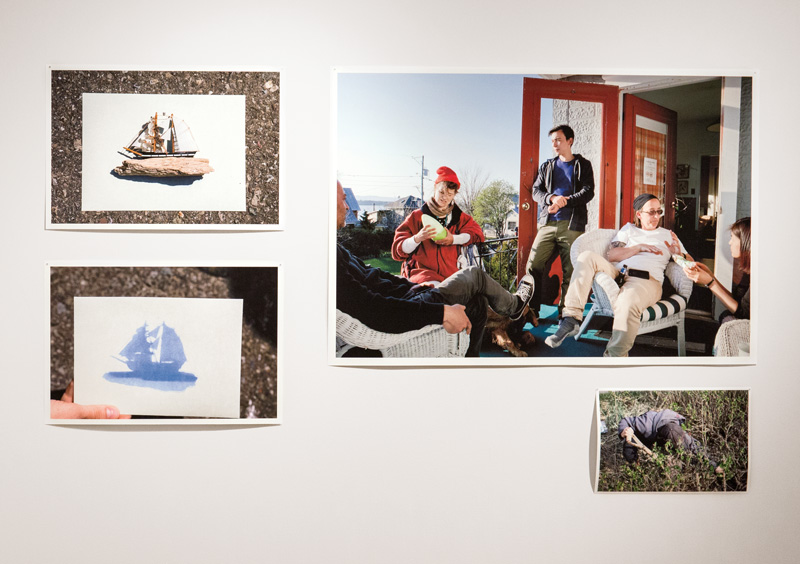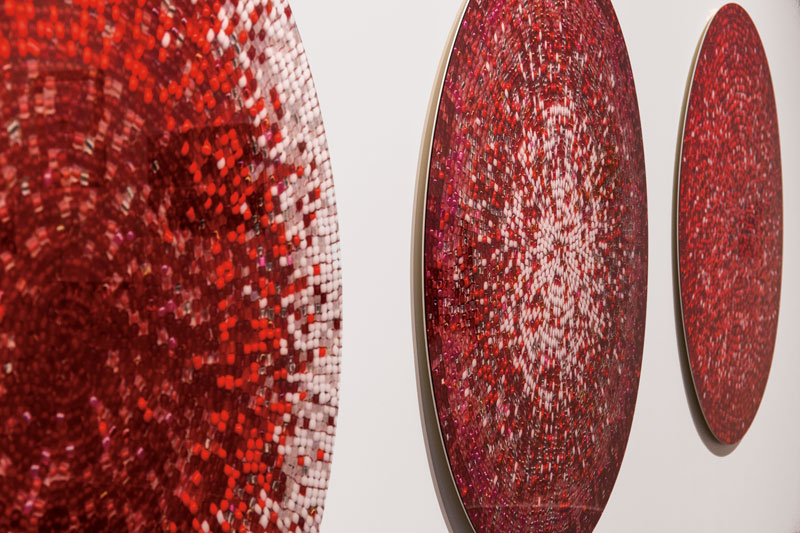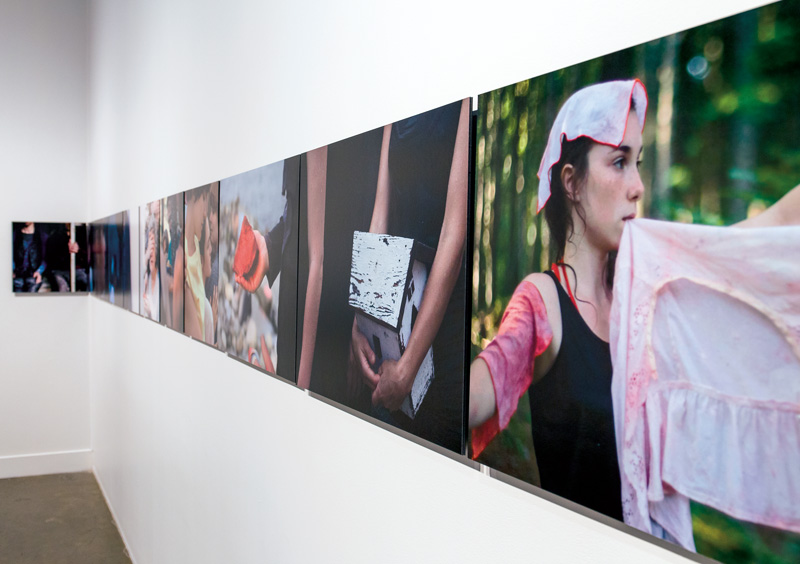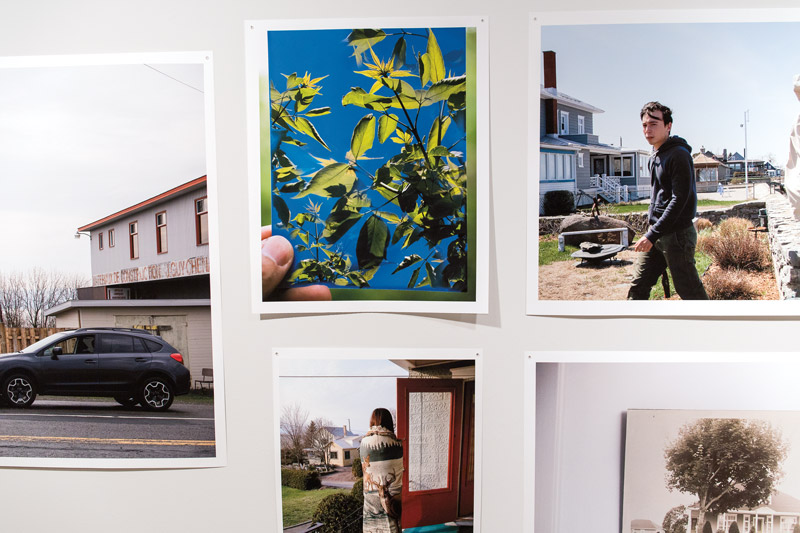By Guy Sioui Durand
Two forms of orality opened and then closed the exhibition Ensemble at VU in Quebec City in October 2016. At the opening, an Indigenous talking circle, led by Nadia Myre, was performed in the large gallery called Espace américain. At the end of the exhibition was a roundtable in the centre of the same gallery, moderated by curator Anne-Marie Proulx.
To the extent that the artworks surrounded the opportunities for speaking, the unifying form that is the circle may also have structured the path – the circulation of gazes – toward these multiple forms of community. It was in fact an organic awareness of knowledge, knowhow, and behaviour that made it possible for the works presented to take shape “ensemble” (together)! Each in its own way, these elements of visual and textual art became evidence of thought in action. It is in this sense that the “broadened” photographic views in Ensemble seemed to urge a perspective on these attractions, dualities, sensualities, and human adventures as being fully marked with the seal of harmony, sharing, or teamwork.
Circulating in Words. The highlight of Ensemble was its opening. The Anishinabe artist Nadia Myre could simply have stood by her three photographic tondi of centrifugal-attraction beadwork that mix the identity-related colours of red (Aboriginal), pink (First Nations Métis and “mixed blood”), and white (Canadians, Québécois, and others). But she was at the gallery to present, in addition, A Casual Reconstruction, a performance of discussions by six characters, standing in a circle within which they moved as they spoke and exchanged words. This dense dialogue expressed diverse states of being, perceiving, assuming the multiple hybridities of the Aboriginal identity through the language used in specific contexts. There were no wild harangues, or theatrical readings, or speeches; rather, there were shifts among imaginary territories made of thoughts, doubts, statements, through the circularity and orality for which the performative body is the raw material. These movements were thus artistic, geographic, and intercultural.
Diffuse Friendship. Like a flock of visual fireflies resulting from so long a friendship that several art genres had to be called upon (love poem by Saint-Denys Garneau, multiple arrangements of photographs inscribed in the light of daily life in the country, cut-out silhouettes, watercolours, and beautifully creased drawings), the artworks by Nathalie Caron and Charles Guilbert gambolled across almost the entire long wall of the large gallery. Here and there, shadows become attached to features, hair, shapes, landscapes, and portraits. They expressed a powerful emotion: that of the inseparable line of shared life among these great artist-friends, that of the time spent together.
From All Our Senses. The alignment of photographic poses began with a first framing at the end of the long wall. In this image, a man sits holding what might be the handle of a placard, like those one sees at gatherings and protest demonstrations or days of action. It is as if he is taking a break, or maybe signalling to us that the series of exquisite images by Jacynthe Carrier captured, one by one, poses evoking senses – hearing, smelling, seeing, touching – perceptions, sentiments, or emotions evoked by stroking, sliding, acquiescence, trust, tenderness, calming, bathed in blue-tinted luminosities as if to showcase the red stone in the central image. Did it not dictate the rhythms of the heart that are the basis for all of these magnificent freeze-frames? Excerpted from motions, from movements, from gatherings and groupings in which beauty sits alongside goodness, the last photograph of a young timeless woman seemed to rise and float. Taking us with her.
Tu m’as dit, or the Addition of Text by Two Pens. Certain weak signals sometimes spell out significant changes in art. To understand them, we must grasp their nuances and subtleties. And this was so for the dialogue written by Caroline Loncol Daigneault and Anne-Marie Proulx, displayed as an integral part of the visual exhibition. It was thus a gentle “conversation,” added to the images as reflections of the works in which “human beings are extended in gestures and gazes . . . as talkative as the piles of photographs . . . on the surface of a golden leaf . . . to find the . . . pearls of our words . . . from red to white . . . [for] there would thus be only that, works with plural signatures .”1 What is more, the fact that the artwork has two signatures testifies again to an attitude setting alight the entire program to come, involving the whole VU team as well as thinking about placing oneself beyond the frame of conventional functions – Anne-Marie Proulx having opted here for the status of artist who imagined such a project, rather than for that of curator.
The Remains of the Party. Without doubt, with Fantômes Charles-Étienne Brochu offered the most ethereal of artworks. On the wall, a small wooden frame surrounded a colourful digital drawing of tree roots – the forest having been destroyed, devastated, chopped down. All this wood that humans use to shelter themselves, adorn themselves, and . . . read this page made of paper (another by-product) that accompanies it, indicated to us that the essential message of Brochu’s proposal was elsewhere. Fantômes found its resolution in the form of postcards that visitors could purchase in the gallery, take away with them, and even put in the mail! Echoing, five hundred years after his death, the strange orgiastic and demonic figures painted by Hieronymus Bosch (1450–1516), Brochu colourfully illustrated, between the trees in the forest, the many blithe and destructive aberrations of Homo sapiens: “Here, anonymous revellers gather in the forest. They drink, they play, they roll on the ground, they cut a few trees. Of the forest, there will remain only vestiges.” The artist goes on, calling them “chaotic and sublime scenes of people [who] coldly taste the indecent flavours of life and death.”
Veneer Art. Stuck on one of the walls in the big gallery was the extended version of Oro es oro es oro es oro, the urban manoeuvre known as “inflections in gold,” produced by Jean-François Prost/Adaptive Actions in November 2011 on either side of the Mexico–U.S. border in the Tijuana and San Diego public markets. Essentially, the artist painted objects and elements of urban furniture – such as the front of a small mobile counter – gold, while obeying the random process of “conversations with workers, malabaristas [jugglers], maintenance clerks, and smugglers in the border market.” As we know, El Norte – the North – spread the thirst for gold from south to north – first to the conquistadors, and now to poor people hankering for some Klondike or other, like the nugget of a better life: wealth.
Two things became significant here. The first was the broadening of the spectrum of urban interventions from the macropolitical utopia of creating “situations” of urban revolution to the myriad of micropolitical labels trying to get out of the rut of organized participation – the term “mediation” being its latest version – to fashion relational aesthetics, performative manoeuvres, or, in this case, “adaptive actions” under the anti-globalist “glocal” slogan of thinking globally and acting locally. Second, we know that certain images become more impactful thanks to the support on which they appear. We can admire here the idea of a gigantic contact sheet attached to the wall, linking images and texts of the Oro project, a sort of visual inclusion in the exhibition somewhere between the ephemeral in situ presence of the site online and the reading of the book.
The Outre-vie / Afterlife Collective. Many photographic prints of multiple formats occupied the three walls of the Espace européen, the smaller of the two VU galleries. Although they were made by different photographers, none of the works was individually signed.2 Thus, it was the sum that predominated, as did the attachment to a single space, that of a photographic mission in Kamouraska to capture the luminous streaming of the river and the springtime and autumnal changes in a rural environment the simple charm of which never disappoints. With the river and Route 132 serving as horizon, a visual framework began to emerge. Together, the artists tried to traverse this moment of shared life as art photography. Their images testify to a process like a “making of” by members of the group taking photographs in nature, who pose, who have their cameras and tripods, and who are also the collective subject.
In this regard, there are two unique gems among the lot, subtle and sublime images that fully achieve their status as artworks: first, the shot of the reflection of the table in the glass front of the sideboard that gives a glimpse of a beautiful table set for the meal that brings everyone together, for shared living “before” art; then, the same table on which are spread the photographic prints that adorned the walls of the exhibition. Certainly the shared life of the collective’s members had preceded art.
Translated by Käthe Roth
2 The Outre- vie / After Life collective consisted of Jessica Auer, Jacques Bellavance, Velibor Božovic´, Gwynne Fulton, Katie Jung, Jinyoung Kim, Lise Latreille, Celia Perrin Sidarous, Marie-Christine Simard, Bogdan Stoica, Andrea Szilasi , and Chih-Chien Wang coalesced around Raymonde April.
Guy Sioui Durand, a Wendat (Huron), is a sociologist, theoretician, independent curator, and art critic. As a speaker, his performed harangues express Indigenous orality. His book L’art comme alternative. Réseaux et pratiques d’art parallèle au Québec (1997) is a standard reference work. He teaches Aboriginal art at Kiuna Institution. He is president of Éditions Intervention and a member of the Aboriginal Curatorial Collective.





